Human Flower Project
Living Unabridged
With his Cambridge garden in bloom, John Levett still wanders back to London—something about having to take it ALL in, more than once.
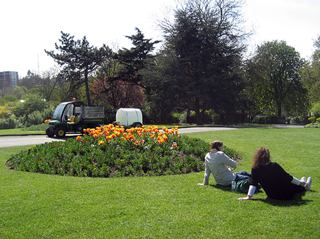
May outing in South London, with mound of tulips
Photo: John Levett
By John Levett
In my small flat I have a utility room. Like all utility rooms it’s the place where everything goes when there’s no longer room for everything. Like all utility rooms it gets a periodic clear-out when everything is cleared-out and then replaced in different order, looks tidier and gives the glow of a well-done job. I’ve just finished the ‘clear and replace’ for this decade including the ‘I-never-knew that-I’d-still-got-that’ interlude that often takes up half a morning, mulling over contents of a stack of magazines along with the pauses for the accompanying remembrances & reminiscences.
Robert Musil’s The Man Without Qualities is an old friend during these sessions. It’s been read but it still hangs around in the part of my brain that says: “Now read it again properly.”
“But I read it from cover to cover,” I protest. “But you weren’t paying attention all the time. Were you, you scurvy oik?” I give in. No I wasn’t.
I get stuck (or stick myself) with these books — doorstops that challenge the reading mountaineer. Not for me Skidelsky’s abbreviated one-volume life of Keynes. I’m an original three-volume dude. Bertrand Russell? Two volumes please. War and Peace? “Do you have it in the original Russian? Preferably in a gothic typeface.” No kidding. I can recall buying a clutch of Dostoyevsky in the late ‘60s and picking up a Penguin Teach Yourself Russian at the same time.
It came from the learning-reading stage. The great thing about learning to read was that my next book was always bigger than the last—instant gratification; instant prizes! By the time I’d arrived at Wyss’s The Swiss Family Robinson (unabridged) by age eight or nine, I felt I was now First Division quality. I can’t remember whether I understood it all, but my mother’s ambition (who else’s?) and now mine (socialization in action) ruled—Big Time Reading. The multi-volume encyclopaedia rampart was breached next. I’m still a sucker for the thud of the seriously big volume.
Next came museums. We never went anywhere without seeking out one. It never mattered what size. A cubby-hole somewhere in a village on the Kent coast or the Gothic scrape of South Kensington: all the same to me. Get some!
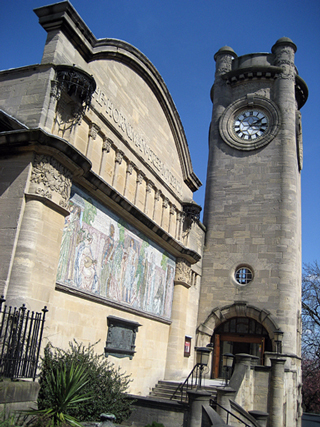 The Horniman Museum
The Horniman Museum
Photo: John Levett
But not quite. There was always one that attracted more, and that was The Horniman Museum in Forest Hill in South London. It had almost completely passed out of memory until last year when I took a roundabout bus ride from Vauxhall to Catford and passed by it. I’ve no idea why it arose in this part of London. It was built by the tea trader Frederick Horniman (the architect was Charles Townsend who also designed the Whitechapel Art Gallery). I remember well Horniman’s tea being sold in the small grocer’s shop my mum ran after the war; maybe she made the connection and thought it worth a visit or more likely took the trip when she was a kid. Horniman’s daughter, Annie, caught herself up with the occult tribes of the 1890s, met up with W.B. Yeats (biography by Roy Foster, two volumes; accept nothing less) and went on to found the Abbey Theatre in Dublin.
When I used to visit in the 1950s it was a predominantly ethnographic museum and that’s what fascinated. I came away with a desire to carve, hew, sculpt, pot, mould and all the rest that goes with that enlightening moment that precedes a life of artistic remaking of the world. In my case nothing of the sort happened. Socialization again. I was carved out to be an engineer according to my putative father, so Meccano for me (which was, at that time, a reasonable stab at a career considering I’ve never had the patience to wait for anything to dry and the carving and hewing soon became bandaged out).
I bussed back to it a few weeks ago but I’d lost the itch. I still go to art galleries but the hold-all of the great Victorian museums no longer holds something for me. I loved Townsend’s building as I love Arts ’n Crafts stuff anyway (Morris, Voysey, Jekyll, Lutyens, Mackintosh, Webb) but walked on by, ticking off the visitor centre, the bandstand, the all-glass conservatory (the influential Crystal Palace had moved from Hyde Park to nearby Sydenham in 1854 after the Great Exhibition leading to Forest Hill become more popular than before), the bandstand and neat gardens and out into South London suburbia and its gardens.
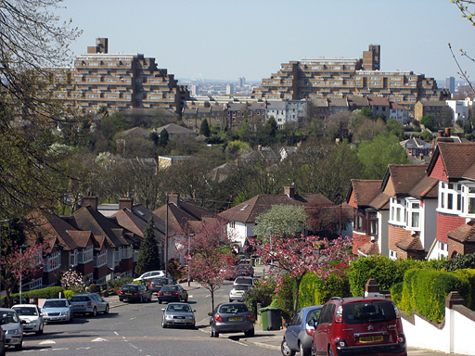
View of Dawson Heights, May 2010
Photo: John Levett
Why I still nose around suburban front gardens I still have no idea: maybe the expectation of something fresh. Early azaleas browning over, magnolias decently shedding blooms after their flush, hedge and rock garden flourishing and declining in equal measure, bird bath features, chipping and paving—the usual suspects. A feeling like another-day-in-the-office surfaced until Dawson Heights rose on an adjacent hill between where I stood and the hazy shape of Wembley Stadium further North.
So, down the hill and up the other side for a look. Dawson Heights was a late ‘60s public housing development with the best view of London ever. Talking to the residents, I gathered that the streets around are clogged on New Year’s Eve from those driving up for a prime view of the fireworks. You can scan all the way from the estuary across the east end and the Olympic Park and as far north as Alexandra Palace. (For the unexpecting newcomer, London is a very hilly city.)
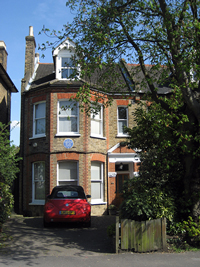 Forster’s house, or is it Forester’s?
Forster’s house, or is it Forester’s?
Photo: John Levett
I walked off downhill for something else and think, am sure, that I’ve come across a gem. Set back from Lordship Lane I come across an outpost of E.M. Forster. I snap the house (the blue plaque says it all) and stand there thinking how Forster-ish, how much the neat semi-detached of “The Taupe” (Lytton Strachey’s name for him), how much he fitted-in to bourgeois banker-and-shipping-agent Surrey. I’ve never quite got Forster’s reputation as a member of the Modernist tribe; never have seen him in the role of innovator, ground-breaker, pusher of possibilities. He always seems too comfortable in his drawing-room; not quite going where he knew he wanted to go (a touch of Henry James restraint).
It turned out that my standing-think, while useful, was wasted on the Forest Hill semi. Looking at the snaps when I got home, it turns out it was the home of C.S. Forester. (“How many times have I told you? Don’t forget to wear your glasses!”)
Walking suburbia is something I do a lot. It’s as if I’m walking amongst my people. If I were walking Berlin I’d be walking the suburbs (and do). Walking them in South London is always a home coming. A couple of years ago I detoured through Beckenham and Bromley (H.G. Wells and David Bowie) finishing up in the street that mum and gran and I moved into in 1954. The shop had been bricked in but the ‘garden’ (worthy of a pair of inverted commas) was still squeezed in between the back of the house where the outside lavvy used to be and the back of the banana warehouse, surviving against the odds. It used to be stuffed with tomato plants which mum sold in the shop and hollyhocks (what suburban English garden could do without them?).
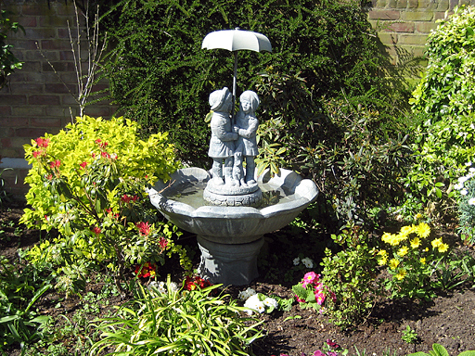
Rain-ready yard art, South London
Photo: John Levett
It seems it’s against the odds always in suburbia—the battle against next door’s triffids and kids; the battle against the encroachment of overpowering new-builds taking out the afternoon sun; the battle against Sunday afternoon’s ‘Exile On Main Street’ blaring from two streets away just as you’ve settled in the deckchair with your mug of tea and a sandwich; the battle against restraint whilst taking the soft acceptance road or going back indoors. Suburbia was always a step up and away; a step towards the mythical village of the yeoman citizen or trying to recreate it—your plot in the open field, your sheep on the commons.
Whenever I make these detours I’m walking my history. I know that and know that it’s time to throw it up. One more project and then I’m done with it—the same promise I made myself last year and those before. I’ve just finished a Miles Davis biography and got reminded of how he always broke up the group once it got comfortable and easy with itself. It’s like that in art—do what ever it is you’re avoiding doing unless you’re afraid of finding out you’re a one-trick pony (Jackson’s problem) or afraid that you just like the comfort (Bacon’s problem). I was at the Henry Moore show at Tate Britain a couple of week’s back and stood in the last gallery of elm carvings and wondered where it all went wrong. Like Francis Bacon I’ve always felt that Moore looked over the edge of where he might go and decided to stay at home. Back to suburbia (or Hertfordshire in his case).
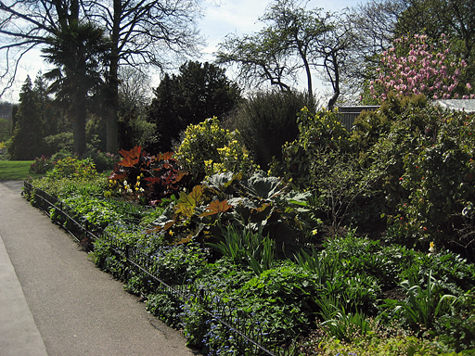
Beating the odds, May 2010
Photo: John Levett
Why write all this? Because it’s Sunday afternoon and I’m sitting in the garden in my deckchair. Next door’s kids have just gone in, the various lawns aroundabout have been mowed or razored, Black Eyed Peas from over the fence are back in the cd case and I have blooms. Canary Bird was eleven days late this year but now flourishes; Cantabrigiensis and Hidcote Gold are beside it; R.Webbiana is showing and I’ve currently got a black-spot-free Lawrence Johnston thanks to a permanent drip feed of water to the roots (Monty Don tip). The delphinium seedlings from a March seeding are thriving (forty-eight potted-up already) and the alpine troughs are showing flower as are the fritillaria; I’ll be getting iris blooms within the week.
So, I’m here in the stockade and it’s so easy to stay here and tell myself it’s where I always wanted and want to be (not entirely true; I’m still holding out for an acre on the South Downs). But there’s still an itch that tells me to go walk in a different direction (actual and metaphorical) the next time I walk out.

